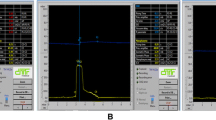Abstract
The influence of Eustachian tube (ET) dysfunction on the inner ear fluid pressure and thus on the inner ear function in Meniere’s disease has been discussed controversially. So far, most of the studies examining ET function in inner ear disorders indirectly analyzed ET function by tympanometric methods. The present study directly studied ET function in inner ear disorders by sonotubometry. Healthy subjects and patients with Meniere’s disease, sudden sensorineural hearing loss, cholesteatoma and chronic suppurative otitis media were examined by sonotubometry. Mean increase of sound pressure intensity (dB) and mean duration of sound pressure increase (s) were analyzed. Highest mean increase of sound pressure intensity was seen in healthy subjects when using >5 dB peaks (11.6 ± 0.7 dB) and >0 dB peaks (9.6 ± 0.6 dB). Comparative analysis including bilateral ears showed decreased ET function in patients with cholesteatoma (p = 0.002) and in patients with Meniere’s disease (p = 0.003) when using >0 dB peaks. Examination of each specific ET opening maneuver showed impaired ET function in pathological ears of patients with cholesteatoma and with Meniere’s disease, during yawning (p = 0.001; p < 0.001), dry swallowing (p = 0.010; p = 0.049), Toynbee maneuver (p = 0.033; p = 0.032) and drinking (p = 0.044; p = 0.027). Mild ET dysfunction is detected in patients with Meniere’s disease by direct sonotubometric assessment of ET function.



Similar content being viewed by others
References
Tumarkin A (1966) Thoughts on the treatment of labyrinthopathy. J Laryngol Otol 80:1041–1053
Lall M (1996) Meniere’s disease and the grommet (a survey of its therapeutic effects). J Laryngol Otol 83:787–791
Montandon P, Guillemin P, Häusler R (1988) Prevention of vertigo in Ménière’s syndrome by means of transtympanic ventilation tubes. ORL J Otorhinolaryngol Relat Spec 50:377–381
Maier W, Ross U, Fradis M, Richter B (1997) Middle ear pressure and dysfunction of the labyrinth: is there a relationship? Ann Otol Rhinol Laryngol 106:478–482
Hall MC, Brackmann DE (1997) Eustachian tube blockage and Meniere’s disease. Arch Otolaryngol 103:355–357
Ingelstedt S, Ivarsson A, Tjernström O (1976) Immediate relief of symptoms during acute attacks of Meniere’s disease, using a pressure chamber. Acta Otolaryngol 82:368–378
Cinnamond MJ (1975) Eustachian tube function in Meniere’s disease. J Laryngol Otol 89:57–61
Forquer BD, Brackmann DE (1980) Eustachian tube dysfunction and Meniere’s disease: a report of 341 cases. Am J Otol 1:160–162
Politzer A.1869 (1908) Cited by Politzer A. In: Lehrbuch der Ohrenheilkunde. 5. Stuttgart: F. Enke, Auflage, vol 1
Virtanen H (1978) Sonotubometry. An acoustical method for objective measurement of auditory tubal opening. Acta Otolaryngol 86:93–103
Committee on Hearing and Equilibrium guidelines for the diagnosis and evaluation of therapy in Meniere’s disease. American Academy of Otolaryngology-Head and Neck Foundation, Inc. (1995) Otolaryngol Head Neck Surg 113:181–5
Di Martino EF, Thaden R, Antweiler C, Reineke T, Westhofen M, Beckschebe J, Vorländer M, Vary P (2007) Evaluation of Eustachian tube function by sonotubometry: results and reliability of 8 kHz signals in normal subjects. Eur Arch Otorhinolaryngol 264:231–236
Heermann J (1988) Unilateral patulous eustachian tube with tinnitus, inner ear damage, vertigo and sudden deafness–collagen injection. HNO 36:13–15
Robinson PJ, Hazell JW (1989) Patulous eustachian tube syndrome: the relationship with sensorineural hearing loss. Treatment by eustachian tube diathermy. J Laryngol Otol 103:739–742
Maier W, Hauser R, Münker G (1992) Eustachian tube function in sudden hearing loss and in healthy subjects. J Laryngol Otol 106:322–326
Iwano T, Kinoshita T, Hamada E, Ushiro K, Yamashita T, Kumazawa T (1991) Sensation of ear fullness caused by eustachian tube dysfunctions. Auris Nasus Larynx 18:343–349
Franz B, Anderson C (2007) The potential role of joint injury and eustachian tube dysfunction in the genesis of secondary Ménière’s disease. Int Tinnitus J 13:132–137
Hofman R, Segenhout JM, Albers FW, Wit HP (2005) The relationship of the round window membrane to the cochlear aqueduct shown in three-dimensional imaging. Hear Res 209:19–23
Feijen RA, Segenhout JM, Albers FW, Wit HP (2004) Cochlear aqueduct flow resistance depends on round window membrane position in guinea pigs. J Assoc Res Otolaryngol 5:404–410
Carlborg B, Densert B, Densert O (1982) Functional patency of the cochlear aqueduct. Ann Otol Rhinol Laryngol 91:209–215
Di Martino EF, Nath V, Telle A, Antweiler C, Walther LE, Vary P (2010) Evaluation of Eustachian tube function with perfect sequences: technical realization and first clinical results. Eur Arch Otorhinolaryngol 267:367–374
Conflict of interest
None.
Author information
Authors and Affiliations
Corresponding author
Rights and permissions
About this article
Cite this article
Park, J.JH., Luedeke, I., Luecke, K. et al. Eustachian tube function in patients with inner ear disorders. Eur Arch Otorhinolaryngol 270, 1615–1621 (2013). https://doi.org/10.1007/s00405-012-2143-z
Received:
Accepted:
Published:
Issue Date:
DOI: https://doi.org/10.1007/s00405-012-2143-z




